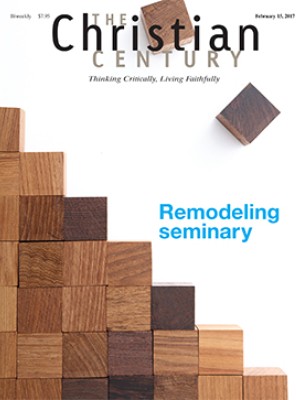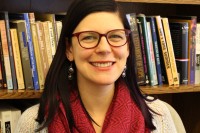New $14 million fund supports historic congregations
The National Fund for Sacred Places aims to help churches raise funds, restore their buildings, and find new community partnerships.

Restoring a congregation with a historic sanctuary is not just a matter of repairing a building from the past. It’s about energizing a church’s mission into the future.
That vision is put forth by the leaders of the National Fund for Sacred Places and of the churches that have received grants for stewardship of their facilities. The fund was established as a partnership between the National Trust for Historic Preservation and Partners for Sacred Places, an organization with headquarters in Philadelphia that works with historic congregations. Together they have received $14 million through the Lilly Endowment, which they will distribute in matching grants of up to $250,000 to congregations of various faith traditions during the next four years.
The initial 14 recipients are located across the United States. One is Quinn Chapel African Methodist Episcopal Church, the oldest African-American church in Chicago, which has hosted high-profile political figures and jazz and gospel musicians. It was a station on the Underground Railroad and one of its pews is in the new National Museum of African American History and Culture in Washington, D.C.
Read our latest issue or browse back issues.
Quinn was once considered an endangered site by the National Trust for Historic Preservation. During the past decade the congregation has completed several phases of renovation, and it plans to put the matching grant from the national fund toward sealing and restoring the church’s stained-glass windows.
James Moody, pastor of Quinn Chapel, sees three dimensions to restoration. First is “restoring the relationship of the people to God,” the second, “restoring the relationship of the congregation to the community,” he said. In Quinn Chapel’s neighborhood that has meant working to reduce drug trafficking and prostitution. In one instance, a person who had been addicted to heroin got clean, stayed out of prison, and became a church usher.
The third dimension is restoring the church’s facilities and the blocks around it. “What has happened has changed not only the way people in this area see themselves but also the way people on the outside see the value this area holds,” he said.
When Moody became pastor in 2002, the congregation had 35 worshipers. Now it has 400 and is a church that “truly works together,” said John Gay, the architect who won the bidding for the building restoration years ago—and was inspired to join the church.
Corlis Moody, who is married to Pastor Moody, has written grant applications for each phase of renovations.
Even in the midst of the repair work, Quinn Chapel’s building is open seven days a week. “You cannot bring your historical site into today if you do not open your doors,” she said. “Life produces life.”
Corlis Moody attended training on capital campaigns that gathered local congregational leaders to learn from each other about the blessings and burdens of having historic status.
“We believe in preservation,” Corlis Moody said. “But it limits what you can do to your property.”
Chad Martin, director of the National Fund for Sacred Places, said the fund is accepting letters of interest until May 1 for its next round of grants (there is a form available at fundforsacredplaces.org). They are looking for buildings that have architectural significance or some other noteworthy feature and that are still owned by a congregation or closely related nonprofit.
The size of the congregation does not matter as long as it is willing to form partnerships in order to raise its share of the funds.
Partners for Sacred Places has been operating for 30 years “in the midst of the landscape witnessing churches closing,” a landscape that mainline congregations know well, Martin said. “It will be really critical in the coming years to be discerning and savvy about which congregations have prospects for continuing into the future.”
Partners for Sacred Spaces offers strategic planning and discernment for congregations, even if that leads toward a decision to close. At that point, it’s still possible to create a plan for keeping the space for purposes in line with the church’s mission, rather than having it get “snapped up by developers before there’s a chance for community input,” Martin said.
The fund expects to give grants to 50 congregations in its first four years and hopes to continue work beyond that, Martin said.
Tuomi Forrest, executive vice president for Partners for Sacred Places, said the organization intends to provide some level of assistance to every applicant to the national fund, whether that’s advice, training, or referrals.
Consulting and training are at the core of the organization’s work, Forrest said. It has offered programs to nearly 1,000 congregations to help them make a plan for community outreach, building repair, and fund-raising.
The national fund is about more than giving money, Forrest said. “It’s really us working hand-in-hand with congregational leaders to ensure that they have successful capital projects, but also that the congregation is sustained and strengthened.”
Partners for Sacred Spaces collaborated with the University of Pennsylvania in a scholarly study that showed that “the average urban church or synagogue contributes $1.7 million in value to its community each year.” And nearly 90 percent of the people who benefit from programs based in a congregation’s building are not members of that congregation.
“These places have a civic value, they have a public value,” said Robert Jaeger, president of Partners for Sacred Places. “It’s so important in this era to say to our government leaders, ‘These places have value for everybody. So please do not see them just as Methodist or Presbyterian or Jewish or Catholic. It’s really a place that serves us all.’”
Partners for Sacred Places sits down with church leaders to look at the full array of options for finding funding for their building. Some of those are “low-hanging fruit” such as sharing more space with nonprofits, but may also include the possibility of selling air rights, the vertical space above a property, which can be “enormously complicated,” in Jaeger’s view. Air rights have also proved controversial when sold to make way for luxury condominiums.
Trinity United Methodist Church in Idaho Falls, Idaho, which was founded by 19th-century Methodist missionaries to the Rockies, caught the eye of the national fund after applying for a state-level heritage grant. As it raised money for one of the initial grants from the national fund for adding bathrooms and restoring the masonry and roof of the building, it received $5,000 for planning and an architectural assessment.
The church hosts free concerts and events in partnership with the Museum of Idaho, which doesn’t have an auditorium. The building is seen as being open for secular activities, which isn’t true of many churches in their area, said Ruth Marsh, the pastor.
“The room was built with great acoustics, since one hundred years ago they didn’t have ways to amplify as we do now,” Marsh said. “More and more these spaces with great acoustics are going away.”
Nancy Stewart, chair of the church’s board of trustees, who is also attending the Partners for Sacred Places Capital Funds Campaign 101 course, said, “This is an opportunity, but we have to go beyond our comfort level to find the people to donate.”
Receiving the grant from the national fund has been an opportunity for the congregation to move from patching and mending the building to focusing on long-term vision, Marsh said. “One of the things that’s really hard to quantify is how much getting connected to Sacred Places has been a hope-filled experience for this congregation.”
Her two years as pastor have been filled with conversations about the future. The congregation has considered selling the building and constructing a new one elsewhere. Having the perspective that “we’re doing the building work to serve the community,” Marsh said, “helps the congregation to be healthy and grow.”
A version of this article appears in the February 15 print edition under the title “Fund supports historic congregations.”






